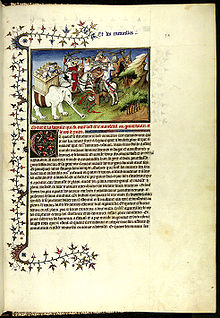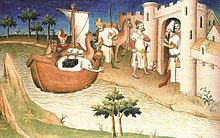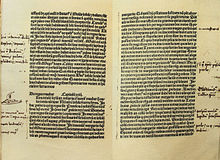Il Milione
Il Milione (German translation: The Milione ) is a description of Marco Polo's journey to the Far East from the end of the 13th century .
Surname
Milione was possibly the short form of the polo family's nickname, Emilione . However, the name has not been definitively clarified: it is commonly interpreted as an allusion by contemporaries to reports of the legendary treasures of the Orient, which seem unreliable. The book is also known as Le meraviglie del mondo or Devisament du monde (German: The wonders of the world or division of the world ).
The title of the original manuscript of the work was French and was probably Le livre de Marco Polo citoyen de Venise, dit million, où l'on conte les merveilles du monde (“The book of Marco Polo, citizen of the city of Venice, called Milione, in which of the wonders of the world is reported ”).
Emergence
After an oral report by Polo, his travelogue was recorded between September 1298 and July 1299 by Rustichello da Pisa (also Rusticiano da Pisa ) in old French. The two men were allegedly captured in Genoese in 1298 after the sea battle near Curzola . During the joint detention in the Palazzo San Giorgio used as a prison, Polo is said to have dictated the memories of his travel experiences to his fellow prisoners, who had previously distinguished himself as a collector and publisher of Breton knightly episodes. The use of the French language in the Italian-speaking area to produce writing would not have been unusual. Around 150 later, sometimes heavily falsified manuscripts are based on the lost original. It was only modern literary studies that attempted to restore the original text as far as possible, which was then published in reconstructed form in 1928.
analysis
The work, which exceeds the other medieval travelogues in terms of scope, number of countries visited and accuracy, is not a chronological travelogue, the course of the two journeys is only described in the prologue. In the individual chapters, geographical information is given on countries and cities, local products are described, customs and social forms, historical events and curiosities, whereby Marco Polo is more interested in the everyday life of the residents than nature. Although the work is a largely factual travelogue, it also contains blood-soaked stories of battles, vivid descriptions of magnificent palaces, enchanting gardens with strange flowers, solemn ceremonies, idols and potentates. With his stories, Polo has created a work that can definitely be compared with the French chivalric novels. A highlight of the book is the episode of the " Old from the Mountains ", which has been interpreted in a variety of ways in a modified form up to modern times. The story of life in the magnificent summer residence of the great Khan , as well as the customs of the old Chinese Empire, is of particular historical value . The author always remains discreetly in the background. Its enchantment by the strange surroundings can be felt all the time.
Importance of the work
Polo's contemporaries often misjudged his work as a fairy tale collection. However, due to the abundance of geographical and ethnographic information it contained, it was of great value for the following age of explorers. So Christopher Columbus had a copy of the travelogue in his hands, which he provided with numerous comments.
The credibility of Marco Polo's reports is still controversial in historical research.
Critical text editions
The so-called Edizione integrale by Luigi Foscolo Benedetto, Marco Polo: Il milione, prima edizione integrale, a cura di Luigi Foscolo Benedetto, sotto il patronato della città di Venezia is fundamental to this day . (= Comitato geografico nazionale italiano. Publicazione No. 3). LS Olschki, Florence 1928. The following editions are also worth considering:
-
Franco-Italian version
Gabriella Ronchi: Marco Polo, Milione. Le divisament dou monde. Il Milione nelle redazioni tuscany e franco-italiana. with a foreword by Cesare Segre, Mondadori, Milan 1982. -
Tuscan version ("Ottimo")
Valeria Bertolucci Pizzorussa: Marco Polo, Milione. Version toscana del Trecento. 2. verb. Edition, Adelphi, Milan 1982. -
Latin text of the manuscript Z
Alvaro Barbieri: Marco Polo, Milione: redazione latina del manoscritto Z, versione italiana a fronte. Fondazione Pietro Bembo, Milan; Guanda, Parma; 1998, ISBN 88-8246-064-9 . -
Venetian version
Alvaro Barbieri, Alvise Andreose: Il Milione veneto: ms. CM 211 della Biblioteca civica di Padova. Marsilia, Venice 1999, ISBN 88-317-7353-4 . -
French version (“Grégoire”)
Philippe Ménard (editor-in-chief): Marco Polo, Le devisement du monde (= Textes littéraires français. Vol. 533, 552, 568, 575, 586) Droz, Geneva 2001–2006, 5 volumes, ISBN 2-600-00479-3 , ISBN 2-600-00671-0 , ISBN 2-600-00859-4 , ISBN 2-600-00920-5 , ISBN 2-600-01059-9 . -
Latin version by Francesco Pippino da Bologna
Justin V. Prášek: Marka Pavlova z Benátek Milion: Dle jediného rukopisu spolu s přislušnym základem latinskym. Česká akademie věd a umění, Prague 1902.
Modern translations
- The wonders of the world - Il Milione . Translation from old French sources and afterword by Elise Guignard (= Insel-Taschenbuch vol. 2981). Insel-Verlag, Frankfurt am Main / Leipzig 2009, ISBN 978-3-458-34681-4 .
See also
Web links
Individual evidence
- ^ International Columbus Exhibition in Genoa 1951 . In: Universitas . tape 6 , no. 2 , 1951, p. 825-827 .
- ^ Dietmar Rieger: Marco Polo and Rustichello da Pisa. The traveler and his narrator . In: Travel and travel literature in the Middle Ages and in the early modern period . Rodopi, Amsterdam 1992, ISBN 90-5183-325-3 , p. 289
- ↑ Tucci, Marco Polo, Lexikon des Mittelaltes , Volume 7, Col. 71
- ↑ Frances Wood : Marco Polo did not get to China . Secker & Warburg, London 1995, ISBN 3-492-03886-7 .



